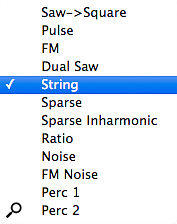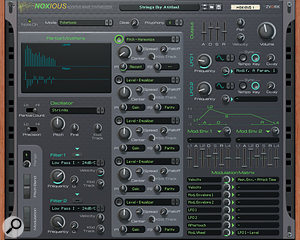We scrutinise two Rack Extension additive synths and look at how to add harmonic complexity to any source.
Taking its place in Propellerheads' range of premium Rack Extensions, and offering an interesting and quite friendly slant on additive synthesis, comes Parsec (€99$119 from shop.propellerheads.se).
Parsec is labelled a 'Spectral Synthesizer', and that's a good term for it, because this is not the kind of additive synth, like some old hardware beasts of old, that has you messing about with individual sine waves. Its basic sound-generation topology is Generator / Modifier / Amplifier, not dissimilar to a subtractive synth's Oscillator / Filter / Amplifier, and just about as easy to work with. It's just that there are unexpected features and surprising possibilities along the way.
 Propellerheads' latest Rack Extension is a 'Spectral Synth', serving up harmonic digital complexity, analogue-like warmth, and lots in between.
Propellerheads' latest Rack Extension is a 'Spectral Synth', serving up harmonic digital complexity, analogue-like warmth, and lots in between.
To begin with, an overview. Parsec has two Generator/Modifier 'Sound Engines', A and B, located left and right on the front panel. A is always on, while B can be turned onand off via its little blue Enable button. To put a useful visual slant on it, sounds start out in the light-grey Generator sections, pass upwards into the (unlabelled) Modifier sections with the X and Y knobs, and then combine via the big Balance knob to pass downwards through the Amp Envelope and effects section. Two LFOs and two Envelopes are freely assignable (along with a whole lot of other modulation sources) to various bits of the synthesis architecture via the mod matrix at the bottom of the panel. And that really is about it.
Let's return to those Generators. Clicking their grey triangles brings up a pop-up menu choice of waveforms. Actually they feel more like wavetables, because the soft-knob below the little display section explores a whole gamut of harmonic variations for each of them. There are some analogue-oriented sounds in there — 'Saw->Square', Pulse, and Dual Saw (with variable detuning, almost as if there were two oscillators) — and plenty of more additive-sounding fare too, along with an FM soundalike and noise generators. The knobs alongside offer familiar pitch and keyboard tracking parameters, but the Filter section here is unexpected. Turning the Slope knob left dials in an ever-steepening low-pass filter curve, up to what is effectively a 'brick wall' curve of more than 100dB/octave. Turning it right generates an EQ-like high-shelf boost. The Freq[uency] knob controls where the fun begins in both cases.
 It may be an additive synth at heart, but in Parsec the starting point of sound production is still a range of harmonically rich waveforms.
It may be an additive synth at heart, but in Parsec the starting point of sound production is still a range of harmonically rich waveforms.
Now for those intriguing Modifiers. There are two in series, labelled 1 and 2, and both with the same capabilities. Look in their pop-up menus and first you'll see familiar subtractive filter types;LPF (low-pass) at 12 and 24 dB/octave, an HPF (high-pass), and a band-pass. So if you want to treat Parsec as a subtractive synth, go right ahead, select one of these, and adjust frequency and resonance with the X and Y knobs. Beyond this things get less familiar. Twenty one additional modifier types sculpt and twist the harmonic spectrum in sophisticated ways, resembling comb filters, EQ, and the oscillator sync and PWM (pulse width modulation) sounds of some subtractive synths. There's also chorus-like ensembles, unisons, body resonances and vocal formants. A Modifier is, then, so much more than just a filter; it forms an equal partner with a Generator in determining the sound of Parsec, behaving sometimes like a filter, sometimes like an oscillator, and at other times like an effect unit.
To see how easy it is to build great, useful sounds in Parsec, try this simple string machine patch. Start by creating an instance of Parsec, and then right-click an empty part of its panel and choose Reset Device. This initialises everything, and sets you up with Sound Engine B turned off, which is fine for now.
 Modifiers alter the harmonic or 'spectral' structure of your sound, according to a range of familiar and unusual schemes.
Modifiers alter the harmonic or 'spectral' structure of your sound, according to a range of familiar and unusual schemes.
First, in Generator A, choose the String waveform; this gives you a harmonically rich, vaguely violin-like buzz. In Modifier 1 just above, choose PWM. This creates a swirling, moving effect, just as expected. To tame the default settings, set the X soft knob (pulse width) to its middle position, and Y (which controls a kind of self-contained modulation effect) to about 1/3 the way up. Instantly much more string-machine-like, but still a bit raw.
Next, for the next-door Modifier 2, choose Ensemble 1. Turn the Y (Threshold) knob right down for now — it controls another self-contained modulation effect. And set X (Detune) to your preferred level of detuned lushness. And now for a crucial step: go to the very top-right of Parsec and turn up the Spread control to broaden the stereo width of the whole synth. You might also want to raise the Attack and Release in the Amp Envelope a little, to soften the note beginnings and endings.
Still too buzzy? Jump back to your Generator A, nudge down the Filter Slope knob a little bit, and adjust the Freq knob to suit. Add a bit of vibrato as well? Find 'LFO 1' in the modulation matrix, choose 'A Pitch' (that's Generator A) and turn up the first Amount knob a little. Control the vibrato rate with the Rate knob in the LFO 1 section.
Finally, it's time to explore some additive weirdness. Try turning up Generator A's soft knob, which controls 'Stretch' for the String waveform. Gradually, the proper harmonic series of the sound is warped, ending up as a DX-like bell timbre. Next, turn up Modifier 2's Y(Threshold) knob most of the way. This changes the ensemble effect's modulation characteristics, leaving only widely spaced, sporadic harmonics to come and go. The X (Detune) knob makes a huge difference to the effect, with glistening bell sounds at low settings, and unpredictable chirps when turned up higher.
As you can see, a vast amount is possible with just one Generator. Add in the other, and bear in mind that every Generator and Modifier type has its own distinct capabilities, character and idiosyncrasies, and you start to grasp the power and potential of this synth.
 Noxious: not a lost episode of The Young Ones, but another Rack Extension additive synth.
Noxious: not a lost episode of The Young Ones, but another Rack Extension additive synth.
Noxious
Parsec wasn't the first additive synth to the Reason platform, that accolade goes to Zvork's €72$89 Rack Extension Noxious. And even though it looks a bit different, it uses a very similar synthesis concept to Parsec; using modifiers (the central sections labelled A to E) to alter the harmonic structure of waveforms produced by an oscillator (sited on the left).
Noxious has more waveforms than Parsec, two proper multi-mode filters, and five modifiers rather than just two. But arguably it comes off worse in both ease of programming and sheer attractiveness of sound: there's only the one oscillator, no wavetable-like variations of the basic timbres, no way to introduce the detuning, PWM, chorusand ensemble effects that allow Parsec to sound quite fat, and no onboard effects. There's more nerdy terminology flying around too. However, adding Reason's half-rack UN16 Unison device can really warm and widen Noxious's output, and adding reverbs or delays is easy, of course. So don't discount this bold and interesting synth. It has its own distinct flavour, and if additive tones are your thing, you'll probably want it as well as Parsec.
Rentaghost
Spectral action isn't only restricted to additive synths in Reason. First off, the venerable, brilliant Malström 'graintable' synth covers some of the same sonic territory as Parsec, with any number of harmonically complex wavetables: there are even some 'AdditiveWave' varieties. Its two oscillators also sport Shift knobs, which introduce interesting harmonic skews.
For other sources, even audio tracks, try the bundled BV512 vocoder. After creating one for a device in your rack you'll often be met with silence, because with default settings you need to rig up a modulator input (traditionally supplied by a microphone) to actuate the effect. But that requirement can be dispensed with if you switch to Equaliser mode. Then, with further variation provided by the Band Count knob, BV512 becomes a one-of-a-kind equaliser. Click and drag to create an EQ curve in the lower display, and use the Shift knob to the right to wreak wholesale harmonic shifts into the bass or treble. Another flavour is achievable if you split one of the channels driving BV512's carrier input to its modulator input as well, using the Spider Audio Merger & Splitter device, and switch to Vocoder mode.
Even weirder, for monophonic sources, try applying a Neptune Pitch Adjuster, but only enable its Formant shift section, or use the Transpose section to make octave shifts. Outer limits stuff perhaps, but used on synth basses, guitar leads or indeed vocals it can help you create never-before-heard sounds.








